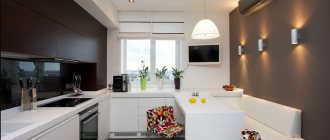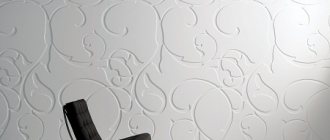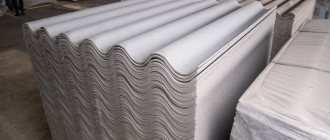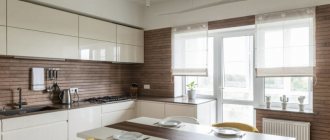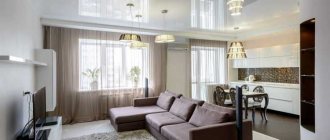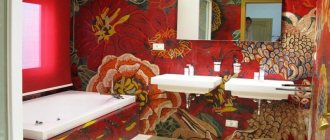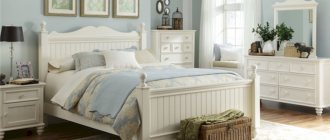Decor options
All decorative elements located on the walls can be divided into functional and purely decorative. The first include the following options.
- Diary on the wall. These can be various wall calendars and note boards. It is quite possible to cover the wall itself with special paint, which turns it into a surface for writing with chalk or a marker.
In any case, the area above the surface of the table, even a kitchen one, is a great place to plan your day over morning coffee.
- Open shelving. You can expand the useful kitchen space with small open shelves suspended above the table. Even very small boards will allow you to fit a lot of useful little things. These could be various spices, beautiful glasses or cookbooks.
- Lamps and aquariums. The wall above the dining table is an ideal place to place a small sconce. You don't always want to turn on bright lights during breakfast or dinner. A small lamp that gently diffuses light will be an excellent addition to a kitchen chandelier. In addition to lamps, you can mount a small flat aquarium into the kitchen wall, into which fish or snails will be placed. Such a bold decision will make any kitchen a real designer find.
- Watch. Another classic element of the kitchen interior is a wall clock that allows you to measure the time for baking or marinating. Placing them on the wall of the dining area would be a great solution.
In addition to the above options, there are quite a lot of different products designed exclusively for interior decoration.
- Tree. Boards with carved or burnt patterns will fit perfectly into the kitchen interior, especially if the rest of the interior is made of natural materials or in natural shades.
- Mirrors. An unusual but increasingly popular solution is to decorate the dining area with one large or several small mirrors. This will expand the space and make the room brighter.
The main thing is to hang the mirror higher so that splashes of food and liquid from the kitchen table do not stain its surface.
- Pictures and compositions. A classic option for wall decor are various paintings, embroideries and panels. If one of the household members is fond of needlework, a place on the kitchen wall is ideal for such crafts. In recent years, it has been especially popular to decorate walls with complex modular paintings, each of which has its own part of the image. You can make an interesting collage of family photos or paint the very surface of the wall with paints.
The main thing is to soberly assess your artistic skills. In cases where they are considered insufficient, it is better to use the services of a professional artist.
- Dishes. Once gone from the walls, but once again gaining popularity, ceramic plates with paintings are decorations. This could be a whole composition, divided into several parts, or souvenirs from various trips.
The main thing is that such fragile jewelry is securely fastened and does not break if dropped.
For tips on decorating walls in the kitchen, see the following video.
Kinds
We have already briefly touched on the wallpapers that suit us, let's expand this list to something acceptable.
Luxurious dining room, and what a chandelier, just look
Wallpaper made of paper is suitable for the dining room only if it is treated with a special water-repellent compound. These are inexpensive paper wallpapers, sold as “washable”; they are mainly produced by Russian and Ukrainian factories.
I would like to note that the colors of such wallpaper are not the most successful, more suitable for country houses, verandas, and bathrooms.
We divide vinyl-based wallpaper into several subgroups:
- A soft, washable vinyl made specifically for kitchens and dining rooms. It is distinguished by its textured texture, high moisture-resistant qualities and a rich range of colors. They occupy the middle price segment of the wallpaper market, closer to inexpensive.
- Hot-stamped rigid vinyl, usually applied to a non-woven backing. This is meter-long, highly durable wallpaper, which is produced by the vast majority of factories. The Germans and Italians produce excellent designs, and domestic manufacturers copy them well. There are currently more rolls of increased width than standard 53 cm wide sheets.
- Silkscreen printing, vinyl woven with fabric fibers. It has a beautiful, highly durable texture that does not fade over time and can withstand the roughest cleaning. Silk-screen wallpaper is ideally glued to absolutely flat walls, since all surface defects are visible through the thin wallpaper.
- Foamed vinyl. We do not recommend this type of vinyl, since it is similar in texture to paper wallpaper with acrylic foam. Its surface is rough, absorbing fats, but it is difficult to wash; there is always a danger of damage to the texture.
Paintable wallpaper is made from non-woven fabric and fiberglass. Non-woven fabric is a more versatile material, just suitable for home use, while fiberglass is used mainly for industrial premises.
Related article: Home workshop: children's paper crafts for September 1 (23 photos)
Durable vinyl wallpaper on dining room walls
Liquid wallpaper, or rather not wallpaper at all, but plaster is also quite suitable for the dining room. With their help, a simple and clear monochromatic interior is created, but if a variegated color scheme is needed, you will have to resort to the options described above.
Requirements
To create the right interior that will satisfy all the requirements, you must first put them all together. What is fundamentally important for us in a finishing material, and what we turn a blind eye to.
Combining wallpaper in the kitchen, creating an accent on the main wall
The list is as follows, consisting of four points:
- Strength and wear resistance of the material, increased service life. In addition to the fact that heavy wallpaper is simply glued to the wall, it can withstand many mechanical impacts, which is very important in the unpredictable conditions of the dining room.
- Moisture resistance of wallpaper. To regularly wash wallpaper, it is necessary that its structure can withstand a large amount of moisture, and ideally not get wet at all. Wallpaper in the kitchen and dining room needs to be cleaned constantly.
- The ability not to perceive odors or absorb them. Wallpaper that smells of food does not add coziness.
- Resistant to fading. We are more accustomed to being in the kitchen, illuminated by natural light, so in standard apartment layouts large windows are installed in this room. Therefore, wallpaper must actively resist fading and not lose its color. We are directly interested in preserving their decorative qualities for as long as possible.
Related article: How to make a threshold on a balcony: manufacturing method (photo, video)
The list of requirements is impressive, but not critical; a large number of wallpaper varieties fall under these parameters.
Colors
An important place in decorating dining areas is occupied by the color scheme of finishing materials. In order to make a choice taking into account not only personal preferences, but also general perception, you need to know exactly how a particular color affects a person.
- Red and yellow. These colors increase appetite and create an atmosphere of warmth and comfort. However, a large amount of bright red color has a depressing effect on the human psyche, so it is better to decorate the dining area in soft shades of orange and yellow.
- Green. Green color also increases appetite, and at the same time relieves nervous tension and adds calm. This impact is especially relevant for city dwellers, since large cities with their high pace of life, a large number of dark concrete buildings and a small number of green spaces contribute to an increase in stress levels.
In this case, you should give preference to light and light green shades, since the dirty green color does not look very presentable and neat.
- Blue and purple. These colors are considered more suitable for the bathroom than for the kitchen. They reduce appetite, which is completely contrary to the purpose of this room. However, they can be used to make bright and interesting accents.
- Black and white. There is an opinion that black color discourages appetite, and white, on the contrary, promotes overeating. Perhaps this is precisely the reason that such colors are not used separately in the kitchen interior, but only in combination.
Regardless of what color was chosen to decorate the wall next to the kitchen table, you should remember the following rules:
- glossy surfaces and cool shades expand the space, giving it darkness and coolness;
Custom solutions for the kitchen
There are several design techniques for using space effectively.
Kitchen furniture placed in a niche saves space, does not clutter up and allows you to properly zone the room.
With fireplace
A kitchen where a family hearth or its imitation is located will create an atmosphere of comfort and well-being in the home.
Working kitchen wall
In modern kitchens, the surface above the work area is often left open and wall cabinets are not used. The decor can be just a hood or open shelves.
Dinner Zone
The wall on which the table or bar counter is located can be decorated in different ways, from the simplest and most neutral finish with painting or wallpaper, to the original one using decorative plaster, wooden or MDF panels, and brickwork. The main thing is that the surface near the table is practical and easy to clean.
Decoration near the sink
The apron is sewn up with any waterproof material, such as ceramic tiles. You can also cover the surface from splashes with tempered glass or a continuation of the tabletop material.
The photo shows a work area covered with an apron made of tempered glass.
Shape and size
Before choosing a lamp, decide on the size and shape. As a rule, the chandelier should not be larger than the width or diameter of the table. A single pendant lamp is usually used above a small round or square table. It can be small, or it can be impressive.
And just in this case, it is important to correctly calculate the diameter: subtract 30 cm from the diameter of the table, otherwise the lamp will “press with its volume” - those sitting at the table will feel discomfort.
Say, in a spacious room above a table with a diameter of 120 cm, a chandelier with a diameter of up to 90 cm will look beautiful and proportionate.
